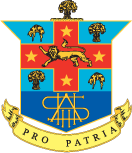
Norman Ernest Borlaug was an American agronomist who led initiatives worldwide that contributed to the extensive increases in agricultural production termed the Green Revolution. Borlaug was awarded multiple honors for his work, including the Nobel Peace Prize, the Presidential Medal of Freedom and the Congressional Gold Medal.

William James Farrer was a leading English Australian agronomist and plant breeder. Farrer is best remembered as the originator of the "Federation" strain of wheat, distributed in 1903. His work resulted in significant improvements in both the quality and crop yields of Australia's national wheat harvest, a contribution for which he earned the title 'father of the Australian wheat industry'.

Queanbeyan is a city in the south-eastern region of New South Wales, Australia, located adjacent to the Australian Capital Territory in the Southern Tablelands region. Located on the Queanbeyan River, the city is the council seat of the Queanbeyan-Palerang Regional Council. At the 2021 census, the Queanbeyan part of the Canberra–Queanbeyan built-up area had a population of 37,511.

Hurlstone Agricultural High School is a government-funded co-educational academically selective and specialist secondary day and boarding school, located in Glenfield, a south-western suburb of Sydney, in the Macarthur region of New South Wales, Australia. HAHS is the oldest government boarding school in New South Wales.
Sir John Grenfell Crawford was an agricultural economist and a key architect of Australia's post-war growth.

Newington College is a multi-campus independent Uniting Church single-sex and co-educational early learning, primary and secondary day and boarding school for boys, located in Stanmore, an inner-western suburb of Sydney, New South Wales, Australia. Established in 1863 at Newington House, Silverwater, the college celebrated its sesquicentenary in 2013. The college is open to boys of all faiths and denominations. Newington has been governed by an Act of Parliament since 1922.

The Farrer Memorial Agricultural High School is a government boys' academically selective and specialist secondary day and boarding school, located in Calala, a small suburb of Tamworth, in the New England region of New South Wales, Australia. It is the only public agricultural high school for boys in Australia.
Dr Douglas Frew Waterhouse CMG AO ForMemRS was an Australian entomologist.

The Clarke Medal is awarded by the Royal Society of New South Wales, the oldest learned society in Australia and the Southern Hemisphere, for distinguished work in the Natural sciences.
Walter Lawry Waterhouse MC was an Australian agricultural scientist, a fellow of the Australian Academy of Science and Clarke Medallist.
George Lowe Sutton was an Australian agricultural scientist and breeder of wheat. In 2005 he was elected to the Royal Agricultural Society of Western Australia Hall of Fame.
James Arthur Prescott, CBE, FRS, was an agricultural scientist.

The Veitch Memorial Medal is an international prize issued annually by the Royal Horticultural Society (RHS).
Cuppacumbalong is an historic homestead located near the southern outskirts of Canberra in the Australian Capital Territory. It is also the name of a former 4,000-acre (16 km2) sheep and cattle grazing property that surrounded the homestead near the junction of the Murrumbidgee and Gudgenby Rivers. The word Cuppacumbalong is Aboriginal in origin and means 'meeting of the waters'. One of the property's early owners Leopold Fane De Salis made a noteworthy contribution to political life during colonial times and furthermore, Cuppacumbalong has strong connections to the life of William Farrer, the father of the Australian wheat industry.

Lambrigg is an historical property close to Tharwa in the Australian Capital Territory which is listed by the ACT Heritage Council as a place of historical significance. It was the residence of William James Farrer who made a major contribution to the wheat industry by developing a strain of wheat that was resistant to wheat rust. Lambrigg was the site where Farrer conducted his work on genetic selection for his wheat varieties.
Strong is the Seed is a 1949 Australian drama film, about the life of agronomist and plant breeder William Farrer.

Margaret Brown Newton was a Canadian plant pathologist and mycologist internationally renowned for her pioneering research in stem rust Puccinia graminis, particularly for its effect on the staple Canadian agricultural product wheat.
The James Cook Medal is awarded on an occasional basis by the Royal Society of New South Wales for "outstanding contributions to science and human welfare in and for the Southern Hemisphere". It was established in 1947 from funds donated by Henry Ferdinand Halloran, a member of the Society.
Robert James Cook is an American phytopathologist. He is best known for his work on soil-borne pathogens affecting wheat. He is the recipient of a Guggenheim Fellowship and the Wolf Prize in Agriculture and is a member of the National Academy of Sciences.










